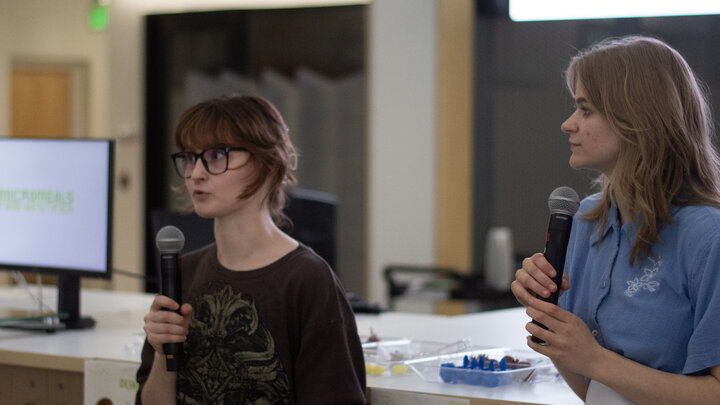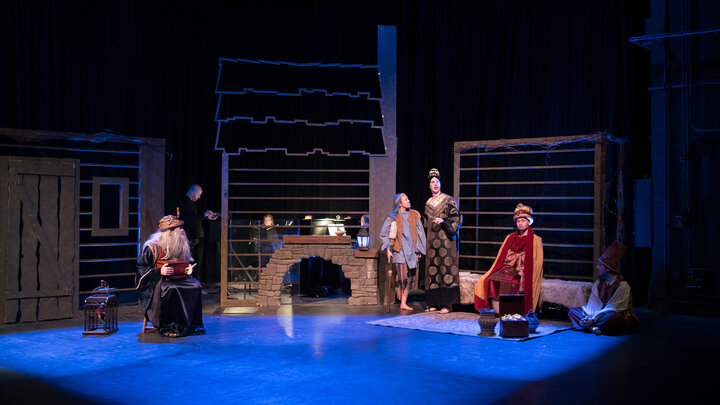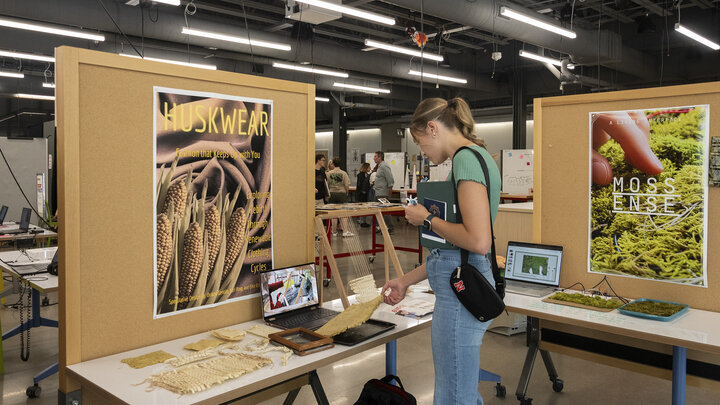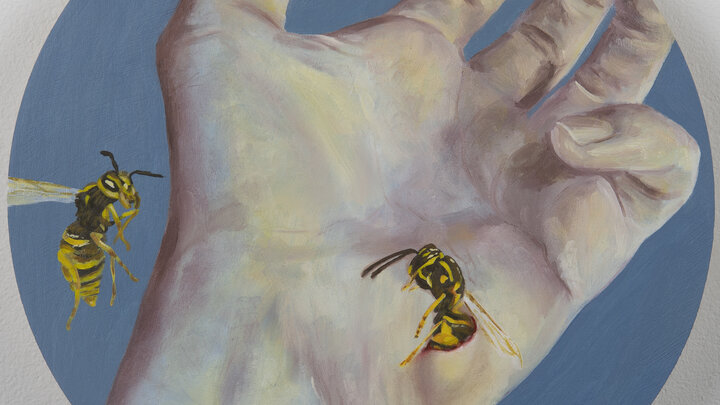Lincoln, Neb.--Twenty emerging media arts students in five groups participated in the Biodesign Challenge (BDC) on May 8 at the Johnny Carson Center for Emerging Media Arts for a chance to compete at the international competition in New York City.
The winning group was “MicroMeals” by Olli Jenkins, Ciara Stueve and Hank Ball. MicroMeals is a speculative design project presented as an interactive, “pop-up” restaurant serving a series of 3D printed food items that each address a pressing climate issue in Nebraska. Jenkins, Stueve and Bell will be invited as finalists to present onstage at the BDC in New York City in June and exhibit their work at the Museum of Modern Art (MoMA) and will attend with generous support from the Johnny Carson Foundation.
“[MicroMeals] stemmed from a project Olli and I did toward the beginning of the year based on trying to speculate a future where humans and plants were as one being,” Ball said. “Becoming less human centered in our designs and more open to a future where plants and humans co-exist as equals.”
Two groups tied for runner-up, including “Scentimedics,” the world’s first scent-based training program, created by Alexah Fort, Marley Hewitt and Isaiah Griffith; and “Eco Perch,” locally sourced, eco-friendly cat furniture that cuts down waste in the pet industry, created by Grace Shepherd, Hannah Romell and Grace Birkland.
Also participating were “Eco Friends,” created by Sebastian Vladimir, Daniel Ratzloff, Eva Kramer, Laynie Berkey and Diego Paniagua Heredia; and “The Connection Box,” created by Micah Fullinfaw, Luke Davidson, Hannah Gish, Lincoln Graham and Peter Schmit.
The judges for the UNL competition included Elizabeth VanWormer, an associate professor in the School of Natural Resources and coordinator of Nebraska One Health; Sasitharan Baalasubramaniam, an associate professor in the School of Computing; Dana Fritz, Hixson-Lied Professor of Art; and Kenra Ordia, an assistant professor of interior design in the College of Architecture.
Fifty schools across 15 countries participated in the BDC, an interdisciplinary education program and competition that works with students to create projects that bridge art, design and biotechnology. BDC aims to pioneer, envision, create and critique transformational applications in biotech.
Invited teams from each participating school will showcase their ideas to 40+ judges from across industry, academia and the arts to the broader public in New York. One team will be awarded the grand prize, the Glass Microbe, which is passed down between winning teams each year.
The UNL students all participated as part of Assistant Professor of Emerging Media Arts Ash Eliza Smith’s Innovation Studio course this semester. Smith has also been invited to present her paper, “Biodesign in the Middle: The Center is an Edge” at the Symposium in New York City at the Parsons School of Design.
Smith was assisted by Media Art Specialist Samantha Bendix. Professor of Sociology Julia McQuillan, Assistant Professor of Emerging Media Arts Dan Novy and Research Impact Coordinator Jocelyn Bosley also provided input and feedback for the projects throughout the semester.
“We are an emerging media arts program, and it’s imperative that we think through both the physical and the digital and how they’re interconnected in terms of their impact on resources,” Smith said. “We are also a program that is uniquely positioned between art and science, and biodesign is just that. I also think it is asking a lot of very important questions that challenge our current modes of extraction and instead ask if we can grow the future? I think there are some exciting ideas on the edges of emerging media—for example, is a cell emerging media? Is DNA emerging media? Specifically, I think as artists and designers, many people are discussing generative AI currently, but less people are discussing biotechnology. I think that most students, after taking this course, would speak to the importance of leaning into the conversations happening around biotechnology.”
Since this was UNL’s first time running this Biodesign Challenge, Smith left it as open as possible for the projects created.
“There’s a range of ideas and projects, some are very actual, and some are speculative,” she said. “Some groups are ready to launch businesses tomorrow, while others are asking very big and important questions about the future. There is room for both kinds of projects—from problem finding to problem solving.”
Smith was impressed with what students came up with for the challenge.
“I was impressed with all of the projects and at the level of comfortability they became with communicating complex ideas from research to design iteration and play testing,” Smith said. “I’m excited to see MicroMeals compete in New York City. I think their project captivated the judges because of its sophisticated visual communication style combined with its very specific Nebraska-centric context, which asks questions about the future of food—from nitrates to drought, they use storytelling and world building in a unique and fun way as a pop-up restaurant that really just becomes a platform for dialogue for communication with community members with different kinds of expertise and lived experiences.”
Smith enjoyed the broad range of what students explored in completing the challenge.
“It was so fantastic to work with students to complete growth experiments from mushrooms to bioplastics,” she said. “We also worked with bacteria, genetic engineering and did our own DNA extraction. There was a Bruno Latour piece called ‘Love Your Monsters’ that we talked a lot about early on with fantastic discourse. In the article, Latour posts that we should ‘care for our technologies the way we care for our children.’ All in all, we had many great ethical conversations around the future of biotechnology and artificial intelligence. We’re particularly interested in the realm of biocomputing and a future where electronics and computation might take on a more biological component.”
Ball, a senior emerging media arts major from Alvo, Nebraska, said participating in the Biodesign Challenge has been beneficial to him.
“Initially I hesitated because I’m not particularly good at science,” he said. “Although after being exposed to Biodesign experiences and projects, I discovered its speculative nature, which resonates deeply with my love for storytelling. As an artist that loves and is inspired by science fiction, I realize that the future of Biodesign is something that I wanted to explore further. It has not only shaped my perspective on Nebraska’s potential in the future, but also influenced my approach to storytelling as a whole.”
Jenkins, a senior emerging media arts major from Lincoln, said she has gained a confidence in her work.
“Being someone who operates in the world of story and speculative design, there are times when I feel like storytelling can never be enough on its own,” she said. “However, through this Biodesign class, I’ve realized that if we don’t have science fiction and wild fantasies about the future, we will never be able to dream our way out of the current existential crisis facing humanity.”
Ball is excited about the opportunity to travel to New York for the international competition.
“I have always wanted to move to New York ever since I was a kid and getting to not only visit there but get the opportunity to share a project that I’m passionate about at MoMA is a huge deal for me,” Ball said. “I just want to thank Ash Eliza Smith and Sam Bendix for this incredible opportunity so early in my career. They have been so helpful in our process, and I look forward to New York.”
Jenkins was excited that their project was chosen to compete in the international finals.
“I was honestly on my tip toes listening to the announcement, because as proud as I was of MicroMeals, everyone in the class had such a fantastic presentation,” she said. “I also didn’t know if the judges would like the speculative route we took. But when our win was announced, I blacked out for a second and then just started jumping up and down. I’m so excited.”
Fort, a senior emerging media arts major from Sidney, Nebraska, said Scentimedics is the world’s first scent-based medical training program.
“This speculative training teaches participants to detect VOCs [Volatile Organic Compounds] released from those with hidden disabilities or disorders, identify with accuracy, and inform others with empathy. The goal of Scentimedics is to inspire connection with those around us and create a space for understanding.”
They came up with the concept after finding a study on how dogs can smell hidden disabilities like Narcolepsy through VOCs.
“We as humans release VOCs every day when we sweat and exhale,” Fort said. “Because of dogs’ exceptional sense of smell, they are able to pick up on biological changes through VOCs so they can alert of seizures before they happen and even detect Covid-19. Specifically the study talked about if there were a way to create stronger VOCs from people with hidden disabilities or disorders, it would be easier to train dogs. From this, we decided to take a speculative approach and train humans on the VOCs released from those with hidden disabilities or disorders. We specifically focused on sleeping disorders for our training because I have Narcolepsy Type 1.”
Fort said participating in the Biodesign Challenge was unlike any other class she has taken.
“I loved that we were pushed to dive into the unknown of science and use our artistic ability to expand upon our research,” she said. “Through this semester, I have gained a better understanding of how important it is for people of different backgrounds to work together. There should be more scientists making art and more artists in STEM. There is so much we can accomplish when we work in multidisciplinary environments.”
Fullinfaw, a senior emerging media arts major from Omaha, Nebraska, helped create “The Connection Box.”
“My group came up with the concept for the Connection Box while discussing the health benefits of meditation and human interaction,” he said. “Originally we were designing a large group meditation walkthrough experience, but I proposed that we scale it down to the core of the exercise.”
The Connection Box is a living sculpture that utilizes biofeedback to facilitate a connection between two people.
“It is an installation that responds to an age of stimulation addiction and the epidemic of loneliness,” Fullinfaw said. “The three phases of the experience allow users to sit with themselves, reflect, and be present with another person. Each participant’s heart rate is reflected through a blinking LED, and the synchronization of both head rates is shown on a third LED. We’d like for the Connection Box to make people realize how easy and impactful it can be to simply sit in a quiet space with someone, without the need to talk.”
Fullinfaw said he learned a lot from participating in this project.
“First, I learned how important it is to get a group on the same page to ensure that we are all working towards the same goal,” he said. “I also learned how being present with someone improves our health. I have found myself putting my phone away more often and striking up more conversations with strangers. I enjoyed being able to use scientific articles and research as a basis for creating a somewhat fictional experience. I found a joy in blurring the lines between science and art through storytelling.”
Kramer, a junior emerging media arts major from Holyoke, Colorado, said their EcoFriend started as a pitch by Berkey that revolved around making Polly Pocket-esque dolls.
“We started playing around with all our ideas and came up with the idea of an androgynous fashion toy with materials for kids to make bioplastic clothes and packaging that transformed into a house for the toy,” she said. “As we thought more about what would be most playable for kids, we changed the creation of bioplastics from something the kids do (as it requires high heat) to something we do. This morphed into the EcoFriend we know now, where bioplastics make up the figure itself, and the clothes are made from reclaimed fabric.”
Kramer said participating in the Biodesign Challenge empowered her to play in science.
“I also gained a much deeper understanding of the ethical issues surrounding biotechnology, the state of sustainability in today’s world, and how speculative design can be used in a scientific context to push for a better reality,” she said. “There are so many ways the arts and sciences can interact to make the world a better, more beautiful place, and I hope that I can continue to explore how to connect science to my artistic practice.”
Smith hopes emerging media arts students will compete in the challenge next year.
“We have even written it into one of the Grand Challenges should we be successful,” she said. “I view this as a potential to collaborate interdisciplinarily with science, art and engineering classes across campus, including architecture, computer science, virology and more. We welcome anyone to reach out who would like to run the course together in the future.”
May 22, 2024



